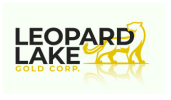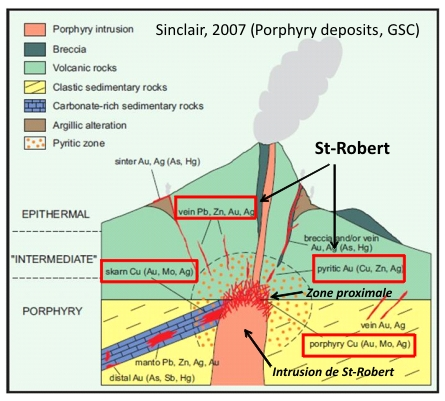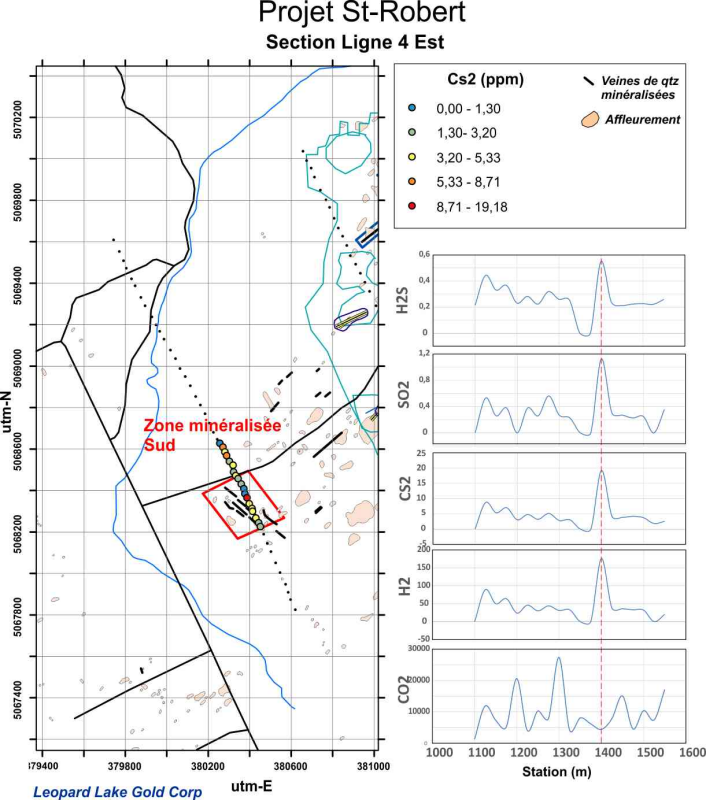Archive
Leopard Lake Gold Corporation (LP) Announces Results of Geochemical Exploration on the St-Robert-Bellarmin Property (QC)
 | |||||||||
November 21, 2024 – TheNewswire - St-Robert-Bellarmin, Quebec, Canada - LEOPARD LAKE GOLD CORPORATION (CSE:LP) is pleased to announce the results of a Soil-Gas geochemical survey carried out in the area of the former St-Robert Metals mine, and more specifically in the South mineralized zone. The survey was realized as part of an FRQNT-MRNF-Leopard Lake Gold Corp partnership to develop and test a geochemical method for detecting hidden sulphide mineralized masses under Quaternary glacial sediments and forest soils covers in Appalachian and Abitibi mineralized zones. Unlike traditional soil-geochemical methods, which are impacted by glacial dispersal processes, among other factors, anomalies detected by the Soil-Gas method are generally apical to the mineralized bodies. In addition to being able to detect mineralized bodies, this method makes it possible to validate and prioritize electrical chargeability (IP) anomalies in order to avoid drilling graphitic barren zones.
The geochemical survey, carried out by the team of Prof. Richer-LaFlèche (INRS) and PhD student Antoine Cukovic (INRS), was initiated in the summer of 2023. The methodological validation section was carried out on either side of the southern mineralized zone, which contains several Pb-Ag-Bi-Zn-Au and W polymetallic quartz veins. The survey consisted of gas sampling in the vadose zone of the soils and analysis using highly sensitive electrochemical detectors.
The data, presented in Figure 1, show a strong H2S, SO2, CS2 and H2 anomaly located in the center of the southern mineralized zone. This anomaly is perfectly centred on the hydrothermal veins intersected by drilling carried out by JAG Mines Ltd. Unlike the orogenic-type gold mineralization studied in Abitibi, the St-Robert South mineralized zone shows no CO2 enrichment. This is consistent with the absence of carbonation in the vein host sedimentary rocks.
Consequently, LLGC is proud to have contributed to a strategic scientific project for optimizing mining exploration in northern terrains affected by variable thicknesses of Quaternary overburden. LLGC plans to relaunch the Soil-Gas project, focusing on the central and northern mineralized zones of the former St-Robert-Metals mine.
Figure 1. Simplified map of the area of the South mineralized zone of the St-Robert property. The map shows the position of the mineralized zone (veins) as well as the sampling stations for gas sampling. The sections for H2S, SO2, CS2, H2 and CO2 concentrations are also presented.
About the St-Robert Property
The St-Robert property contains numerous mineralizations in pyrite-scheelite-molybdenite-stibine-chalcopyrite (tr.) (north zone), pyrite-galena-scheelite (central zone) and sphalerite-silver-rich galena-pyrite-cosalite (south zone) (Wares, 1985; Cattalani, 1987; Athurion, 2013). According to Wares (1985), the mineralization of the St-Robert property would be associated with a magmato-hydrothermal type system. The cluster of polymetallic showings would be centered above a very strong semi-circular, low frequency aeromagnetic anomaly suggesting the presence of an intrusive mass at depth. The latter would be responsible for the injection of numerous granodioritic porphyritic dykes and also mafic dykes (Fig. 2). In addition, Wares (1985) suggests that at depth, the mineralized system could gradually transform into copper-bearing porphyries and possibly into skarns. Geological contexts, sharing many similarities, are observed in the former Murdochville mining camp (Gaspé area) and also in southern New Brunswick (Mount Pleasant W-Mo-Bi porphyry deposit) (Kooiman et al., 1986). This geological setting shares several similarities with vein mineralization settings commonly observed distal to porphyry mineralisations. The following figure shows the metalliferous zoning and the type of mineralization frequently observed in a context of porphyry mineralization (Sinclair, 2007) with an indication of the exploration target(s) for St-Robert research program.

Figure 2. Simplified geological model of a classical porphyry deposit associated with an intrusive mass. Note the presence of proximal mineralizations near the pluton and distal vein mineralizations in the crustal rocks above the intrusive mass. Modified from Sinclair (2007).
About Leopard Lake Gold Corp.
Leopard Lake is engaged in the business of mineral exploration and the acquisition of mineral property assets in Canada, including the St. Robert property, which is comprised of 224 mining claims in the Riseborough and Marlow Townships in St. Robert Bellarmin, Quebec, and the Stella property located in the Abitibi region of Northwestern Quebec, made up of 52 contiguous mining claims for a total of 2,987 hectares, approximately 65 kilometres east of the town of Val d-Or.
About the INRS and Pr. Marc Richer-Lafleche, P.Geo.
Pr. Richer-LaFlèche's team has solid geological and geophysical experience in the Appalachian region and more precisely in the St-Robert, St-Simon-les-Mines and Temiscouata areas. His team has carried out a large number of geophysical surveys including audiomagnetotelluric, gravimetric, magnetometric and geoelectric studies in the St-Robert Bellarmin area. In addition, he supervised, as a research director, graduate students in economic geology and geophysics who had completed master's theses on the St-Robert mining sector.
Marc Richer LaFlèche, Ph.D., Geo., is a qualified person as defined by NI 43-101, has reviewed and approved the technical information presented in this release
For additional information, and to view a copy of this news release in French, please visit the Company's website at: www.leopardlake.ca
On Behalf of Leopard Lake Gold Corp.
Daniel Bélanger
Chief Executive Officer and President
For further information, please contact:
Daniel Bélanger
Chief Executive Officer and President
(418) 933-3443
Forward-Looking Statements:
This news release contains forward-looking statements and forward-looking information (collectively, "forward looking statements") within the meaning of applicable Canadian and U.S. securities legislation. Forward-looking statements include predictions, projections and forecasts and are often, but not always, identified by the use of words such as "seek", "anticipate", "believe", "plan", "estimate", "forecast", "expect", "potential", "project", "target", "schedule", "budget" and "intend" and statements that an event or result "may", "will", "should", "could" or "might" occur or be achieved and other similar expressions and includes the negatives thereof. All statements other than statements of historical fact included in this release, including, without limitation, statements regarding the exercise of the incentive stock options, are forward looking statements that involve various risks and uncertainties. There can be no assurance that such statements will prove to be accurate and actual results and future events could differ materially from those anticipated in such statements. Forward-looking statements are based on a number of material factors and assumptions. Important factors that could cause actual results to differ materially from the Company's expectations include actual exploration results, changes in project parameters as plans continue to be refined, results of future resource estimates, future metal prices, availability of capital and financing on acceptable terms, general economic, market or business conditions, uninsured risks, regulatory changes, defects in title, availability of personnel, materials and equipment on a timely basis, accidents or equipment breakdowns, delays in receiving government approvals, unanticipated environmental impacts on operations and costs to remedy same, and other exploration or other risks detailed herein and from time to time in the filings made by the Company with securities regulators. Although the Company has attempted to identify important factors that could cause actual actions, events or results to differ from those described in forward-looking statements, there may be other factors that cause such actions, events or results to differ materially from those anticipated, including, without limitation, risks relating to epidemics or pandemics such There can be no assurance that forward-looking statements will prove to be accurate and accordingly readers are cautioned not to place undue reliance on forward-looking statements.
